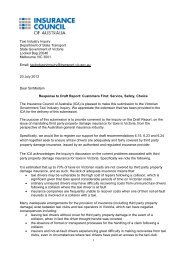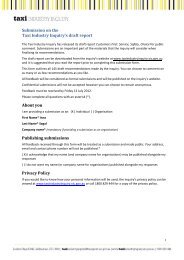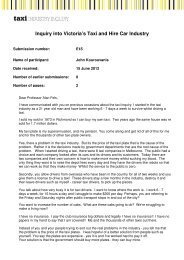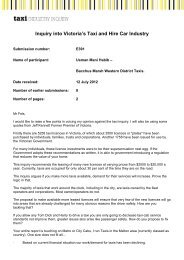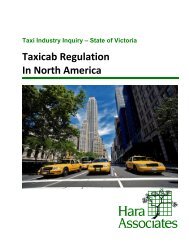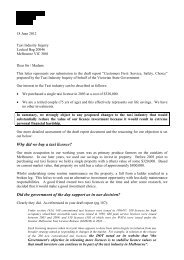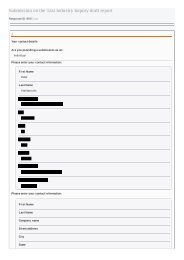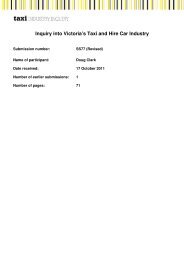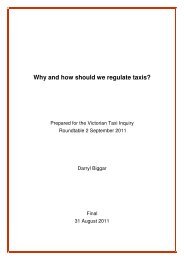Part D â Understanding and improving industry performance (PDF ...
Part D â Understanding and improving industry performance (PDF ...
Part D â Understanding and improving industry performance (PDF ...
You also want an ePaper? Increase the reach of your titles
YUMPU automatically turns print PDFs into web optimized ePapers that Google loves.
From 1953, the use of two-way radio became more<br />
widespread, allowing drivers to be directed to pick-up<br />
locations while ‘on the road’ (rather than having to return<br />
to base) <strong>and</strong> reducing the amount of dead running by<br />
taxis <strong>and</strong> hire cars. 27 This coincided with an increase in<br />
the number of homes with fixed line telephones, enabling<br />
customers to connect directly with their local taxi depot<br />
to pre-book a taxi.<br />
In 1975, a study commissioned by the Victorian Ministry<br />
of Transport analysed the organisation of the taxi <strong>industry</strong><br />
<strong>and</strong> its suitability to meet public dem<strong>and</strong>. The report<br />
concluded that:<br />
The flexibility <strong>and</strong> potential of the current zoning <strong>and</strong><br />
depot system is limited because the inherent<br />
fragmentation does not permit the most efficient<br />
utilisation of the taxi <strong>industry</strong> by location <strong>and</strong> over<br />
time throughout the week. 28<br />
The report recommended:<br />
… every opportunity should be taken to amalgamate<br />
taxi depots … [<strong>and</strong>] the regulation of suburban taxis<br />
should be relaxed to allow them increased freedom<br />
<strong>and</strong> efficiency of movement to assist in meeting peak<br />
dem<strong>and</strong>s in the central areas. 29<br />
The report recognised that efficiency benefits could be<br />
gained by re-introducing competitive tension into the<br />
market for booked services <strong>and</strong> led to the removal of<br />
many of the suburban zones. Around this time, local<br />
monopolies were no longer favoured as the most efficient<br />
structure for organising taxi booking services in the<br />
Melbourne market.<br />
The removal of the limitations on assigning licences to<br />
a third party in 1987, 30 enabled many of the founders of<br />
taxi depots to ‘step back’ from the day-to-day running<br />
of taxis <strong>and</strong> either retire from the <strong>industry</strong> or focus on<br />
their emerging taxi booking businesses. After this period,<br />
taxi depots increasingly became vertically integrated<br />
businesses offering a range of services to their affiliates<br />
in addition to booking <strong>and</strong> fare payment processing.<br />
Insurance, licence brokering, driver training, vehicle fit-out<br />
<strong>and</strong> purchasing became supplementary revenue sources<br />
for taxi depots. Depots evolved from cooperatives owned<br />
by their members to networks owned by people who<br />
were removed from the direct provision of taxi services.<br />
11.3.2. Early regulation of depots<br />
M<strong>and</strong>atory network affiliation has been in place for many<br />
decades, having come into effect during the 1950s with<br />
the requirement for taxi operators to have their vehicle<br />
under radio control of an ‘approved’ depot at all times.<br />
The requirement for depots to be approved gave effect to<br />
a ‘de facto’ regulatory regime, under which the <strong>industry</strong><br />
regulator (the TRB <strong>and</strong> then the VTD) approved depots<br />
against a set of guidelines.<br />
The general premise of the assessment was that<br />
applicants needed to justify that the approval of the<br />
depot would be in the public interest. To comply with<br />
the guidelines, applicants were required to provide a<br />
business plan of their establishment arrangements;<br />
provide a 24 hour warning system for drivers; operate<br />
on a 24/7 basis; conduct inspections of vehicles against<br />
licence conditions; <strong>and</strong> discipline drivers for breaching<br />
government <strong>and</strong> <strong>industry</strong> st<strong>and</strong>ards. 31<br />
While these requirements effectively created a barrier<br />
to new entrants, the regulator was not empowered<br />
to regulate the <strong>performance</strong> of taxi depots after<br />
their approval. The introduction of the taxi <strong>industry</strong><br />
accreditation scheme in 2007 sought to address this<br />
shortcoming.<br />
11.3.3. Technology, innovation <strong>and</strong> the<br />
role of the depot<br />
Victorian taxi depots were early adopters <strong>and</strong> adaptors<br />
of new technologies. This innovation has increased<br />
the efficiency of booking services but has also enabled<br />
further business consolidation, market concentration <strong>and</strong><br />
vertical integration.<br />
In 1974, ‘Bankcard’ was introduced in Australia,<br />
Bankcard was Australia’s first widely available credit card<br />
<strong>and</strong> proved to be popular with retail consumers as an<br />
alternative to cash payments. This change in consumer<br />
behaviour filtered quickly through to taxi services <strong>and</strong> in<br />
1976 Cabcharge established itself as an <strong>industry</strong>-specific<br />
financial services provider for the taxi <strong>industry</strong>. The advent<br />
of Cabcharge enabled taxi operators <strong>and</strong> drivers to<br />
accept non-cash methods of payment for taxi fares. The<br />
administration <strong>and</strong> distribution of non-cash payments<br />
to taxi operators <strong>and</strong> drivers became a complementary<br />
function for taxi depots <strong>and</strong> a major part of their revenue<br />
streams, with customers charged a service fee by<br />
Cabcharge <strong>and</strong> part of this fee paid to the depots. 32<br />
27 Williams, David (1978), Regulation of Taxicabs: The Victorian Case<br />
[manuscript], School of Economics, La Trobe University, Melbourne,<br />
p.22<br />
28 Pak-Poy, P.G. <strong>and</strong> Associates P/L (1975), Study of Melbourne<br />
Taxi Services – Prepared for the Ministry of Transport, Ministry of<br />
Transport, Melbourne, p.iii<br />
29 Ibid., pp. iii-iv<br />
30 See section 6.2.1<br />
31 KPMG Consulting (1999), Op. Cit, p.38<br />
32 The issue is canvassed in greater detail in chapter 12<br />
<strong>Underst<strong>and</strong>ing</strong> <strong>industry</strong> <strong>performance</strong> CUSTOMERS FIRST 231





